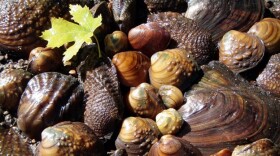If you like to cross country ski you may notice stray oak leaves littering the tracks throughout the winter. And, if you use waxable skis with a sticky wax in your kick zone, you may have had the experience of having your kick wax pick up a leaf, bringing you to a screeching halt (oak leaves do not glide). If the darn oak leaves would just fall before winter, we wouldn’t have this problem. Most trees are either deciduous, and drop their leaves in fall, or are evergreen, and hang onto their leaves for more than one season. The evergreen trees tend to be in more stressed environments, stressed by either cold temperatures or low water availability. Deciduous trees are in better shape nutrient-wise and can afford to produce new leaves in the spring. Deciduous leaves have an abscission layer, or a breaking point, near the base of the leaf where it attaches to the twig, and most plants will cut their losses and drop their leaves come fall.
Oaks are definitely deciduous, but they sure take their time about dropping their leaves. So what is going on? Unfortunately, no one really knows. There are a few observations. It seems that it is mostly younger trees or the branches closest to the ground on older trees that hang onto their leaves. One thought is that the old dead leaves on these low hanging branches discourage browsing of next year’s leaf buds by animals such as deer. One interesting thought is that since many oaks (not around here but in warmer parts of the world) are actually evergreen, oaks may be somewhat intermediate between being evergreen and deciduous. Another thought is that by dropping the dead leaves in spring, it gives the trees a fresh source of nutrients when they are leafing out. Ironwood trees, also known as hop hornbeam, also hold onto their leaves, and their leaves become very ghost-like and nearly transparent. The term for this is “marcescent” a lovely word meaning withering, but not falling off. This mystery is yet to be solved.
Another interesting winter leaf situation can be found in bogs. Leatherleaf is a common bog shrub, with, as you might imagine, very leathery leaves. These leaves are evergreen, but with a twist. The leaves stay on the plant, but turn a deep maroon color in the late fall. Then, as spring approaches, they slowly regain their green color, with the green spreading from the twig toward the tip of the leaf. By spring the plant is fully green again. I don’t know if all the bog shrubs do this – something to keep an eye on this winter and spring.
Another odd winter leaf situation is the tamarack, or larch. This tree is truly deciduous – so what is weird about that? Maybe this is an oddity only a real plant nerd can appreciate, but here’s the thing. Our trees are divided into two big categories. Either they are conifers – that is cone-bearing like the pines and fir trees or they are flowering, like the maples and oaks. Almost all the conifers are evergreen – they hang onto their needles for more than one year. Almost all the flowering plants are deciduous – they lose their leaves in the fall. In the bog, that is almost completely reversed. Almost all of the woody shrubs in the bog are flowering plants, but they are almost all evergreen. Likely this is because bogs are very low in nutrients and the plants can’t afford to produce new leaves every year – it is just too expensive nutrient- and energy-wise. But one of the two dominant conifers in the bog is the tamarack, and it is deciduous, while most conifers are evergreen. The black spruce, the other common conifer is a normal, evergreen tree. So, what is with the tamarack? It is odd for a conifer to be deciduous, and it is odd for a bog plant to be deciduous. Well, there are many ways for a tree to make its way in the world, and this variety keeps us guessing and thinking. One fun thing about tamaracks is that you can cut a few twigs in late winter, bring them inside and put them in water, and you can force them to green up long before they will outside.
We still have a few more months of winter before leaves start busting out all over. Until then, enjoy the deep green of the evergreens until we see that first bright flush of new leaves on our deciduous trees.
For Field Notes, this is Susan Knight of UW-Madison’s Trout Lake Station.









